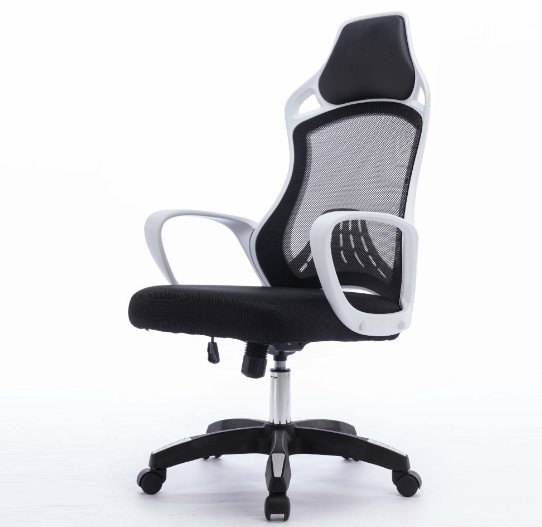Fabric Vs. Mesh Office Chairs: The Great Debate
Dec. 04, 2024
One of the most common dilemmas when selecting a new office chair is choosing between mesh and fabric options. Which material is optimal for a task chair?
Both fabric and mesh office chairs each have their respective pros and cons, which significantly affect your choice. Although both styles can provide ergonomic benefits, the decision primarily depends on factors such as the materials' quality, the manufacturer, and the chair's design.
Anji, with its expertise in comfortable office seating, offers essential insights to help you enhance both wellness and productivity at work.
Let’s dive into the details of chair selection and the numerous options at your disposal.
Understanding Mesh Material
Mesh fabric is a lightweight, breathable material formed through an open-weave pattern where fibers interlock loosely. This design creates a flexible and airy textile frequently utilized in clothing, accessories, and particularly office chairs.
Commonly referred to by terms like power mesh or power net, this resilient fabric is predominantly crafted from synthetic materials such as nylon or polyester.
Exploring Fabric Material
A wide range of textiles, including nylon and polyester, are used in office chair upholstery. These materials are favored for their durability and stain-resistant properties.
In such chairs, foam cushions are layered, contoured, and attached to the fabric, with variations in foam density determining firmness and longevity.
Various fabrics offer different comfort levels and breathability, influencing the chair's aesthetics, quality, and maintenance ease, which can complicate the selection process.
Benefits of Mesh Office Chairs
Mesh chairs offer numerous benefits that make them a preferred option for ergonomic seating.
Breathability
The fabric's open weave promotes excellent air circulation, helping prevent heat build-up during prolonged sitting, thus enhancing comfort and keeping you cool.
Flexibility
The flexible mesh material conforms to body contours, offering support and evenly distributing weight to minimize pressure points. It adjusts with your movements, maintaining support during micro-movements.
Posture Support
Quality mesh office chairs provide support for different body parts, enhancing overall posture.
Durability
High-caliber mesh is resistant to damage and sagging, ensuring a longer lifespan, even in bustling settings.
Modern Style
Mesh chairs sport a sleek contemporary design and come in a variety of colors, enriching office aesthetics with an open and light appearance.
Easy Maintenance
Cleaning mesh chairs is a breeze as spills and stains can be wiped away promptly, and they dry quickly for immediate use.
Drawbacks of Mesh Office Chairs
Despite their many advantages, mesh chairs also have a few drawbacks:
Potential for Low Quality
Certain mesh materials could be of subpar quality, leading to issues such as roughness, sagging, or tearing with prolonged use.
Limited Padding
Mesh chairs typically feature less padding than their fabric counterparts, which might be a disadvantage for those who favor cushioned seating during long work hours.
Aesthetic Limitations
While modern and practical, mesh chairs might not fit with traditional office designs. Moreover, certain models offer limited styles, color choices, and textures, making it hard to find an exact match for different workspace needs.
Expense Considerations
High-end mesh chairs can be more expensive than traditional upholstered chairs, which might affect decision-making for buyers.
Insulation Limitations
More affordable mesh options usually lack the insulating properties found in foam-filled upholstery, making them feel cooler in winter.
Risk of Snagging
The design of mesh material can make lower-quality chairs prone to snagging on clothes or jewelry, which may result in damage.
Benefits of Fabric Office Chairs
Fabric remains a favorite in office settings due to several advantages:
Comfort
Fabric chairs typically contain foam padding, delivering a soft and pleasant seating experience. The upholstery provides that cushioned feeling, making them a popular choice among users.
Versatility
Available in a myriad of colors, patterns, and textures, fabric offers diverse design possibilities. This adaptability allows for seamless integration with your office’s decor and style.
Insulation
Fabric provides significant insulation, particularly useful in cooler surroundings, as it retains warmth for a cozier feel.
Stain Resistance
Fabric is often treated for stain resistance and ease of cleaning. While it may not be as easily cleanable as mesh options, it remains a viable choice for environments prone to spills.
Visual Appeal
Fabric chairs often exude a classic, professional aura, fitting seamlessly into traditional office settings while enhancing formality.
Ergonomic Features
Many fabric chairs come with hidden ergonomic features, like inflatable lumbar support, enabling customization to improve comfort and support.
Cost-Effectiveness
Fabric chairs often have a more attractive price point compared to high-end mesh or leather options, making them a favored choice for home offices and small businesses with budget restrictions.
Availability
Fabric office chairs are widely available, making them a go-to choice for individuals and organizations looking for budget-friendly seating solutions.
Drawbacks of Fabric Office Chairs
While fabric chairs have numerous advantages, they also have some disadvantages:
Cleaning Difficulty
Despite the availability of stain-resistant treatments, fabrics are generally more susceptible to staining compared to mesh chairs. Cleaning them can be challenging due to the foam filling, and spills may leave persistent marks.
Design Constraints
The bulkiness of foam padding can hinder the adaptability of some fabric chairs, possibly compromising essential ergonomic features like seat slide, forward tilt, or height adjustments.
Longevity Concerns
Fabric chairs can show wear over time, fading or fraying in high-use areas which can affect their appearance. Moreover, the foam filling may compress, leading to uncomfortable seating.
Breathability Issues
Fabric generally offers less breathability than mesh, making it less comfortable in warmer work environments due to limited air circulation.
Allergen Accumulation
Fabric can trap allergens, such as dust and pet hair, which may be uncomfortable for those with allergies. Consistent cleaning and maintenance are vital to minimize this issue.
Weight Considerations
Fabric chairs are often heavier than their mesh counterparts, which may impact portability and ease of maneuvering.
Odor Retention
Both fabric and foam can absorb odors over time, especially after spills, which could pose a challenge in eliminating unpleasant smells, particularly in shared workspaces.
Fading Potential
Depending on the quality of the fabric and sunlight exposure, colors could fade over time, impacting the overall appearance of the chair.
The Conclusion: Mesh vs. Fabric
Ultimately, the choice between mesh and fabric chairs hinges on the specifics of the chair's quality and your individual needs. Mesh office chairs are perfect for active workplaces with substantial traffic due to their durability, low-maintenance, and support for the body's natural shapes.
On the contrary, fabric office chairs might be a preferable option if you're on a tight budget or desiring a specific aesthetic. However, keep in mind that fabric chairs may age faster, trap allergens, and feel warmer during summer months.
If you're interested in acquiring an ergonomic mesh office chair, consider a Comfort Seating model. Our designs promote ergonomics and cater to various body types and weights.
196
0
0
None
None



Comments
All Comments (0)